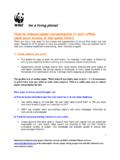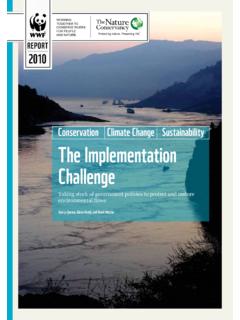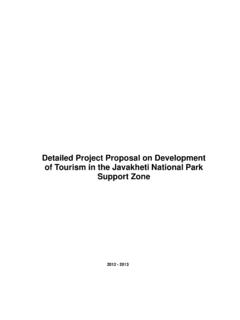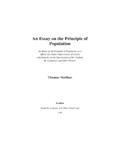Transcription of LIVING PLANET REPORT 2016 - Panda
1 LIVING PLANET REPORT 2016. LIVING PLANET REPORT 2016 SUMMARY. 100% REPORT . RISKS RECYCLED IN T. 2016. Our use of natural resources has grown dramatically, BIODIVERSITY. particularly since the mid-20th century, so that we are endangering the key The LIVING PLANET Index, environmental systems which measures biodiversity that we rely upon. abundance levels based on 14,152 monitored populations of 3,706 vertebrate species, shows a persistent downward trend. RESILIENCE LIVING PLANET REPORT 2016. ANTHROPOCENE The 21st century presents humanity with a dual challenge to maintain Scientists propose that, as nature in all of its many a result of human activity, forms and functions and to we have transitioned from the create an equitable home Holocene into a new geological for people on a finite PLANET . epoch: the Anthropocene . Summary INT. Why we are here To stop the degradation of the PLANET 's natural environment and to build a future in which humans live in harmony with nature.
2 1986 Panda Symbol WWF World Wide Fund For Nature (Formerly World Wildlife Fund). NASA. WWF is a WWF Registered Trademark. WWF, Avenue du Mont-Blanc, 1196 Gland, Switzerland Tel. +41 22 364 9111; Fax +41 22 364 0332. For contact details and further information, please visit our international website at THE SIZE AND SCALE OF THE HUMAN ENTERPRISE HAVE GROWN EXPONENTIALLY SINCE THE MID-20TH CENTURY. AS A RESULT, NATURE AND THE SERVICES IT PROVIDES TO HUMANITY ARE SUBJECT TO INCREASING RISK. SCIENTISTS SUGGEST THAT WE HAVE TRANSITIONED FROM THE HOLOCENE INTO A NEW GEOLOGICAL EPOCH, CALLING IT THE ANTHROPOCENE . THE FUTURE OF MANY LIVING ORGANISMS IS NOW IN QUESTION. SPECIES. POPULATIONS OF VERTEBRATE ANIMALS HAVE DECREASED IN ABUNDANCE BY 58 PER CENT BETWEEN. 1970 AND 2012. THE MOST COMMON THREAT TO DECLINING ANIMAL POPULATIONS IS THE LOSS AND.
3 DEGRADATION OF HABITAT. INCREASINGLY, PEOPLE ARE VICTIMS OF THE DETERIORATING STATE OF NATURE: WITHOUT ACTION THE EARTH WILL BECOME MUCH LESS HOSPITABLE TO OUR MODERN GLOBALIZED SOCIETY. HUMANS HAVE ALREADY PUSHED FOUR PLANETARY SYSTEMS BEYOND THE SAFE LIMIT OF THEIR SAFE. OPERATING SPACE. BY 2012, THE BIOCAPACITY EQUIVALENT OF EARTHS WAS NEEDED TO. PROVIDE THE NATURAL RESOURCES AND SERVICES HUMANITY CONSUMED IN THAT YEAR. TO MAINTAIN. NATURE IN ALL OF ITS MANY FORMS AND FUNCTIONS AND TO CREATE AN EQUITABLE HOME FOR PEOPLE ON. A FINITE PLANET , A BASIC UNDERSTANDING MUST INFORM DEVELOPMENT STRATEGIES, ECONOMIC. MODELS, BUSINESS MODELS AND LIFESTYLE CHOICES: WE HAVE ONLY ONE PLANET AND ITS NATURAL. CAPITAL IS LIMITED. A SHARED UNDERSTANDING OF THE LINK BETWEEN HUMANITY AND NATURE. COULD INDUCE A PROFOUND CHANGE THAT WILL ALLOW ALL LIFE TO THRIVE IN THE ANTHROPOCENE.
4 LIVING ON THE EDGE RISK AND RESILIENCE IN. The evidence has never been stronger and our understanding never A NEW ERA. WWF. been clearer. Not only are we able to track the exponential increase in human pressure and the consequent degradation of natural Earth's ecosystems have evolved for millions of years. This process systems, but we also now better understand the interdependencies has resulted in diverse and complex biological communities LIVING of Earth's life support systems and their limits. in balance with their environment. In addition to their intrinsic value, diverse ecosystems also provide the foundation for human Lose biodiversity and the natural world including the life support livelihoods and well-being. However, the size and scale of the systems as we know them will collapse. We depend on nature for human enterprise have grown exponentially since the mid-20th the air we breathe, water we drink, the food and materials we century.
5 As a result, nature and the services it provides to humanity use and the economy we rely on, and not least, for our health, are subject to increasing risk. To draw attention to our potentially inspiration and happiness. perilous environmental situation, Nobel Prize winner Paul Crutzen and others suggest that we have transitioned from the Holocene into For decades scientists have been warning that human actions are Marco Lambertini, a new geological epoch, calling it the Anthropocene . pushing life toward a sixth mass extinction. Evidence in this year's Director General LIVING PLANET REPORT supports this. Wildlife populations have WWF International During the Anthropocene, the climate is changing rapidly, oceans already shown a concerning decline, on average by 67 per cent by are acidifying and entire biomes are disappearing all at a rate the end of the decade.
6 While environmental degradation continues, measurable during a single human lifetime. The future of many there are also signs that we are beginning a transition towards an LIVING organisms is now in question. And not only wild plants ecologically sustainable future. and animals are at risk: increasingly, people are victims of the deteriorating state of nature. Climate and other predictive models Despite 2016 set to be another hottest year on record, global suggest that without action during the Anthropocene the Earth will CO2 emissions have stabilized over the last two years, with some become much less hospitable to our modern globalized society. arguing they may even have peaked. Rampant poaching and wildlife trafficking is devastating ecosystems, but the and China have Given our current trajectory toward the unacceptable conditions recently committed to a historic ban of domestic ivory trade.
7 That are predicted for the Anthropocene, there is a clear challenge for humanity to learn how to operate within the environmental Perhaps more importantly, the interdependence between the limits of our PLANET and to maintain or restore resilience of social, economic and environmental agendas is being recognized at ecosystems. Our central role as driving force into the Anthropocene the highest levels through the revolutionary approach adopted in also gives reason for hope. Not only do we recognize the changes defining the new set of the world's Sustainable Development Goals. that are taking place and the risks they are generating for nature and society, we also understand their causes. These are the first steps to We need to transition to an approach that decouples human and identifying solutions for restoring the ecosystems we depend upon economic development from environmental degradation perhaps and creating resilient and hospitable places for wildlife and people.
8 The deepest cultural and behavioural shifts ever experienced by Acting upon this knowledge will enable us to navigate our way any civilization. through the Anthropocene. These changes are upon us, and if we are awed by the scale of the challenges that this generation is facing, we should be equally motivated by the unprecedented opportunity to build a future in harmony with the PLANET . WWF LIVING PLANET REPORT 2016 page 4 Summary page 5. THE GLOBAL LIVING PLANET MONITORING SPECIES. INDEX The LPI database is continually evolving and for each LIVING PLANET Figure 2: The distribution of locations providing REPORT a larger dataset is available to use for the analysis. Since data for the LIVING the last LIVING PLANET REPORT , 668 species and 3,772 different PLANET Index populations have been added to the LPI database (Figure 2). Map showing the location The LIVING PLANET Index (LPI) measures biodiversity by gathering of the monitored The dataset is currently limited to populations of vertebrate population data of various vertebrate species and calculating an populations in the LPI.
9 Species. Methods to incorporate invertebrates and plants are now average change in abundance over time. The LPI can be compared to New populations added in development. since the last REPORT are the stock market index, except that, instead of monitoring the global highlighted in orange economy, the LPI is an important indicator of the PLANET 's ecological (WWF/ZSL, 2016). condition. The global LPI is based on scientific data from 14,152 ! ! ! ! ! ! ! ! ! ! !! ! !! !! monitored populations of 3,706 vertebrate species (mammals, birds, ! ! !! ! ! !! ! !! ! !!! ! ! ! ! ! ! ! !!!! ! ! ! ! ! !! ! !! ! !!!! ! !! !!! ! ! !! !!!!!!! ! ! ! !! ! !!!! !! ! !! ! ! ! ! ! !! ! !! ! !!!!! !! !! !! ! ! !!!! ! ! !! ! ! ! ! !! ! ! !!!!! ! !! !! ! !! ! !!! !!!!!! !! ! ! ! ! ! ! ! ! ! ! ! ! !! ! !! !! ! ! ! ! ! ! ! ! ! !! !!!!!! !!! ! ! ! ! ! ! !! !!!! !!!!!! !)
10 !! ! ! ! ! ! ! ! ! !!!!! ! !! !! ! ! ! !!! !!!! ! ! ! !! fishes, amphibians, reptiles) from around the world. ! !!!! ! ! !!! ! !! ! ! !! ! ! !!! ! ! ! ! ! !!! ! ! ! !!! ! !! ! ! ! !! !!! ! ! ! !! !!! !!! ! ! ! ! ! ! ! ! ! ! ! ! !!! ! !! ! ! ! ! ! ! ! !! ! !!! !! !! ! !!! !!! ! ! ! ! ! !!! ! !! ! !!! ! !! !!!! ! !! ! !!! !!!!!! ! !!! !!!!!!!! ! !!! ! ! ! ! ! ! !!! !!! ! ! !! ! ! ! !! !!!! ! !!! ! !!! !!! ! !!!! !! !!! !! ! ! ! ! ! ! ! ! ! !! ! !! !! ! ! !!! ! ! !! !!! !! !!!!! !! !! !! !! !! ! ! ! ! ! !! !! !! !! !! !!!! !!! ! ! ! !! !!! ! !! !!! ! ! ! ! ! ! ! ! ! !! ! ! !! !! !! !! !!!!! !! ! !!!!!! !!! ! ! ! ! ! ! ! ! !!! ! ! ! ! ! ! ! ! !! ! !! ! ! !! !!!! ! !!! ! ! !! ! ! !! ! !! ! ! !!! ! ! ! ! !!! ! ! !! ! ! ! ! ! ! ! ! ! !! ! !! !!! !! ! !! ! ! ! ! ! ! ! ! ! ! ! ! ! ! !!!!! !! !!! ! !! ! !!!! ! ! !! !! ! ! ! ! ! !! !!! !!! ! !! !! ! !















